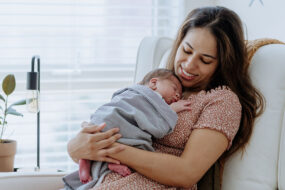My daughter nearly choked to death. Would you know what to do?
Choking can happen in an instant, and it’s common than you think. Mum Sarah Vercoe shares her nightmare experience.
The day it happened was like any other.
My daughter was nearly one; she liked books and dancing to “Africa” by Toto, and watermelon was her favourite food.
At lunchtime, I chopped some up and put it on a plate next to finger sandwiches.
With her in her highchair next to me in the kitchen, I did the dishes while she ate.
They say life as we know it can change in an instant – but nothing prepares you for how quickly that instant transpires.
Choking happens in the blink of an eye
Elbow-deep in suds, I turned from the sink to check on my daughter.
I’m not sure why I did that, at that exact moment. She hadn’t made a noise.
When I laid eyes on her, she was red in the face, her mouth in the shape of an “o” with a blue tinge around it, and her arms were flitting about near her face.
My daughter was choking.
I pulled her out of her highchair and rushed to one of our dining room chairs.
Sitting, I lay her face down along my thigh, making sure her head was past my knee, and lowered my leg slightly so she was angled downwards, then gave her a series of firm back blows.
But nothing came out.
What happened after this is a bit of a blur.
I know I called an ambulance, but I’m not sure when; I know I gave her more back blows; and I know, at some point, a tiny piece of watermelon fell from her mouth to the floor.
I also know the ambulance took what felt like a lifetime to arrive.
Some time between when that tiny piece of fruit tumbled to the floor and when the ambulance arrived, her airway cleared enough for her to suck in gargled breaths.
Later, at the hospital, the doctor told me if I hadn’t known what to do, my daughter probably would have died.

Choking incidents are more common than you think
Australian Red Cross First Aid Trainer Craig King says when he conducts a course, it’s common for people to share choking-related stories.
“It’s not something that is a rare event,” Craig explains.
But it is one of the biggest concerns for people attending his training.
“It’s one of those first-aid emergencies where the timeframe to fix the problem is so short, and time is of the essence,” Craig says.
“Knowing what to do, and not panicking and not relying on an ambulance getting there on time, because sometimes they do and sometimes they don’t, is really critical.”
The doctor told me if I hadn’t known what to do, my daughter probably would have died.
What to do if your baby or young child is choking
Royal Children’s Hospital paediatrician Dr Anthea Rhodes says babies and young children are the biggest group at risk of choking.
Young children have smaller airways, are unable to bite and chew their food properly, and tend to explore by putting things in their mouths.
“They can choke on anything smaller than a 20-cent piece,” Dr Rhodes says.
Signs of choking to watch for
Dr Rhodes says signs of choking include:
- Coughing
- Gagging
- Struggling to breathe or noisy breathing
- Looking panicked
- Changing colour in the face
Do this if your child is choking:
- Call 000 for an ambulance immediately.
- Attend to your child – how you help will depend on the age of the child. “For a child over 12 months of age, you need to sit them up and forward, but if your baby is under 12 months, lay them down on your forearm or across your thigh or lap,” Dr Rhodes says.
- With the heel of your hand, give five firm back blows between the shoulder blades, then check to see whether anything has dislodged.
- If they continue to struggle, repeat with a further five back blows.
- If, at any point, your child stops breathing, you need to roll them over onto their back and start CPR.
Common choking hazards for babies and kids
Dr Rhodes says common choking hazards include:
- Balloons
- Buttons batteries
- Coins
- Hard foods such as nuts, candy, popcorn and lollipops
- Polystyrene beads
- Small toys and toy parts
More on keeping kids safe:
- Home safety: How to prevent and treat burns
- How to score big on sports safety for kids
- Kids and concussion: What all parents should know
- Water safety tips for summer
Written by Sarah Vercoe.






